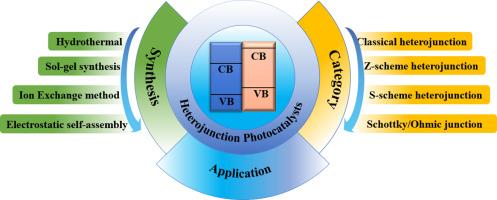Insights into semiconductor heterojunctions for enhanced photocatalytic performance and applications
IF 23.5
1区 化学
Q1 CHEMISTRY, INORGANIC & NUCLEAR
引用次数: 0
Abstract
Semiconductor heterojunction combining with two or more photocatalytic materials has boosted a renovated interest in fields ranging from energy storage to environmental protection, resulting from the special synergistic preponderance in comparison of single-component photocatalysts. Generally speaking, the heterojunction formed at photocatalyst interface promotes the electrons rearrangement due to the discrepancy of Fermi lever, further inducing a robust internal electric field (IEF) which has a positive effect on the photogenerated charge separation and migration, enhancing the photocatalytic performance. The majority of extant research is oriented towards the design, characterization and application of specific heterojunctions, which lacks a comprehensive overview of all the common types of semiconductor heterojunctions. Thus, in order to better understand the photocatalytic mechanisms and construction methods of heterojunction photocatalysts, this review firstly summarizes basic categories of photocatalytic heterojunction systems, and simultaneously takes some typical examples to verify the important function of heterojunction. The design principle of heterostructures, as well as their synthesis methods, are summed up. Furthermore, the practical environmental applications of heterojunction photocatalysts are overall introduced, including environmental wastewater remediation, water splitting, CO2 conversion, H2O2 synthesis and other applications, and the challenges associated with the construction method of heterojunction and the prospects that motivate future research are comprehensively discussed.


半导体异质结对增强光催化性能和应用的见解
与单组分光催化剂相比,半导体异质结结合两种或两种以上的光催化材料,由于其特殊的协同优势,在能源存储和环境保护等领域引起了人们的兴趣。一般来说,由于费米杠杆的差异,在光催化剂界面处形成的异质结促进了电子的重排,从而产生了强大的内电场(IEF),这对光生电荷的分离和迁移有积极的影响,提高了光催化性能。现有的大多数研究都是针对特定异质结的设计、表征和应用,缺乏对所有常见类型的半导体异质结的全面概述。因此,为了更好地了解异质结光催化剂的光催化机理和构建方法,本文首先总结了光催化异质结体系的基本类别,同时通过一些典型的例子来验证异质结的重要作用。总结了异质结构的设计原则及其合成方法。此外,全面介绍了异质结光催化剂在环境中的实际应用,包括环境废水修复、水裂解、CO2转化、H2O2合成等应用,并对异质结构建方法面临的挑战和未来研究的前景进行了全面讨论。
本文章由计算机程序翻译,如有差异,请以英文原文为准。
求助全文
约1分钟内获得全文
求助全文
来源期刊

Coordination Chemistry Reviews
化学-无机化学与核化学
CiteScore
34.30
自引率
5.30%
发文量
457
审稿时长
54 days
期刊介绍:
Coordination Chemistry Reviews offers rapid publication of review articles on current and significant topics in coordination chemistry, encompassing organometallic, supramolecular, theoretical, and bioinorganic chemistry. It also covers catalysis, materials chemistry, and metal-organic frameworks from a coordination chemistry perspective. Reviews summarize recent developments or discuss specific techniques, welcoming contributions from both established and emerging researchers.
The journal releases special issues on timely subjects, including those featuring contributions from specific regions or conferences. Occasional full-length book articles are also featured. Additionally, special volumes cover annual reviews of main group chemistry, transition metal group chemistry, and organometallic chemistry. These comprehensive reviews are vital resources for those engaged in coordination chemistry, further establishing Coordination Chemistry Reviews as a hub for insightful surveys in inorganic and physical inorganic chemistry.
 求助内容:
求助内容: 应助结果提醒方式:
应助结果提醒方式:


